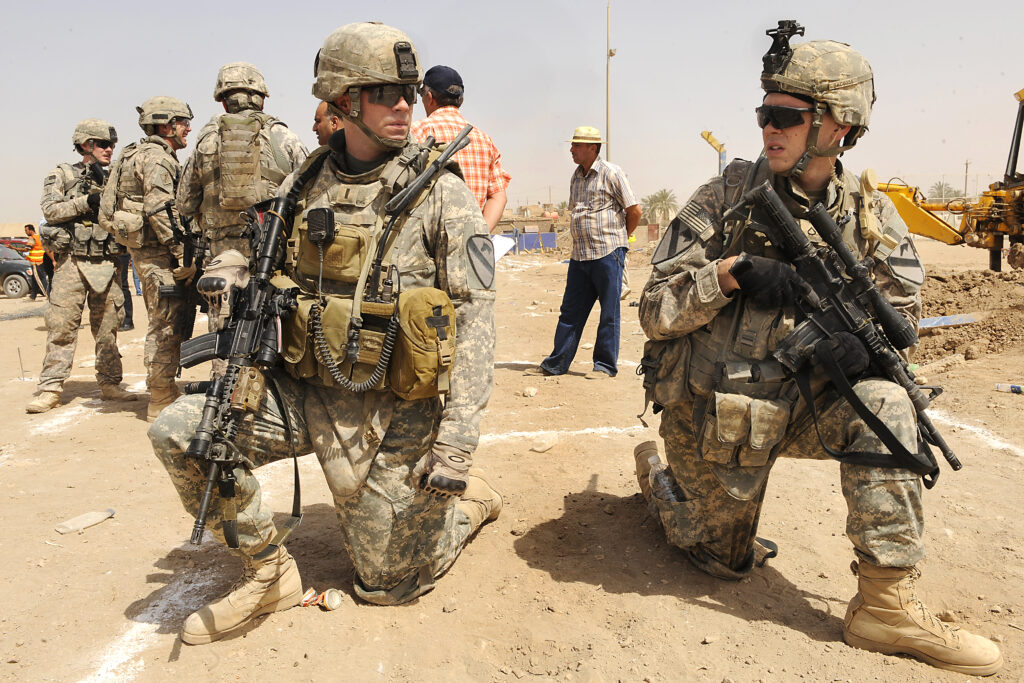Roberto Moll Neto on David Vine’s ‘The United States of War’, a book review

U.S. Army 1st Lt. Joshua Vandegriff, left, and Pfc. Joshua Cahoon during a groundbreaking ceremony for Freedom Field, which is being built near Joint Security Station Ur in Baghdad, Iraq, June 23, 2009 (Credit: U.S. Army photo by SPC. Joshua E. Powell /Wikimedia Commons)
By Roberto Moll* [Reposting] [OPEU’s Choice] [Book Review]
 In The United States of War, David Vine, an anthropologist, faces the challenge of analyzing the global expansion of the United States of America (USA), a task that political scientists, historians, and international relations analysts have mastered. Moreover, Vine characterizes the US as an Empire. The concept is out of fashion because it declines or disappears along with the nation-state. However, as if shouting that “the Emperor has no clothes”, Vine reconstructs the history of the collection of military bases that US governments built and rebuilt in all parts of the world to sustain the Empire of an American elite with transnational ties to subaltern groups. In the process, building bases abroad has become a powerful machine of war and profit.
In The United States of War, David Vine, an anthropologist, faces the challenge of analyzing the global expansion of the United States of America (USA), a task that political scientists, historians, and international relations analysts have mastered. Moreover, Vine characterizes the US as an Empire. The concept is out of fashion because it declines or disappears along with the nation-state. However, as if shouting that “the Emperor has no clothes”, Vine reconstructs the history of the collection of military bases that US governments built and rebuilt in all parts of the world to sustain the Empire of an American elite with transnational ties to subaltern groups. In the process, building bases abroad has become a powerful machine of war and profit.
Vine outlines the history of the network of military bases that underpinned the US empire from independence. At first glance, Vine’s thesis may seem teleological, but it is not. For Vine, the independence process marks the beginning of the transition from the British Empire to the American Empire. Just like the former colonizers, the Americans used the network of military forts to occupy territories and control populations. Soon after independence, US administrations undertook a process of invasion, conquest, and occupation. This network of forts materialized the certainties of the supremacy of white men and Christians over the “others”. Moreover, it strengthened the mythical narrative of the Americans as a chosen people, which is fundamental to imagining the nascent nation. In the process, US troops committed the same abuses and usurpation as the British colonists.
Although not an innovative argument, Vine challenges traditional historiography and current international relations analysis by correctly establishing that the expansion to the West was a process of colonial invasion and subjugation of foreign territories. Historians and analysts of international relations who naturalize and romanticize expansion to the West, even those who present punctual criticisms, like Frederik Jackson Turner, legitimize the process of invasion, international conquest, and a permanent state of war. To paraphrase Immerwahr, they hide the Empire. Even historians and analysts of international relations who tend to base their research on a critical and problematizing approach took a long time to free themselves from the shackles of national narratives and finally “find empire” and colonization in the West.
In the expansion to the West, Vine catches the Empire in its most visible structure: the first military forts in Indian territory. Vine argues that military forts enabled a permanent state of war against indigenous people, shaping US military practices, such as using violence against non-combatants, looting, assassinating leaders, and destroying villages and plantations. This exercise of violence, reproducing the European colonialist heritage, reaffirmed the supposed superiority of white men over indigenous people, shaping the American identity. Moreover, the narrative of civilization against barbarism materialized in the forts legitimized the settlements. For the white settlers, the forts operated as a base for expanding settlements, commercial hubs, and a point of diffusion for Christian missions and nationalism. For the indigenous people, the forts were a weapon of mass destruction over their communities.
From Vine’s standpoint, the Spanish-American War, which for many analysts inaugurated US expansion into the world, was, in fact, a continuation of the expansion to the West. The Spanish-American War was a decisive chapter in the spiral and dialectic chain between invasion, construction of military forts, redefinition of borders, and new invasions, having the narrative of the expansion of civilization over barbarism as the footing of legitimacy. According to Vine, the US victory in the Spanish-American War raised the racial and ideological contradictions inherent in annexing new territories and absorbing new non-white citizens. These contradictions, according to Vine, shaped the Open Door Policy, a different sort of imperialism that forces political control and access to markets without promoting annexation, citizenship, and any rights to conquered peoples. According to Vine, this would be the Template for American colonization in the 20th century. In this scenario, the military bases became even more critical pieces to keep the doors open to the Americans.
During World War II, the US consolidated the global network of overseas military bases that underpinned the construction of hegemony. Vine used Immerwahr’s illustrative analogy to explain how this network of overseas military bases worked: the forty-eight states functioned as a giant heart pumping out materials like planes, bombs, weapons, and supplies; the overseas military bases store and distribute all kinds of military supplies, information and people through the system until they reach the allies and the battlefields. Even isolated and uninhabited islands were home to transmission networks, cables, and weather stations. After the end of the conflict, the US preserved a robust network of overseas military bases that covered the world. According to Vine, the postwar collection of overseas military bases changed America’s relationship with the world. National Defense began to assume the presence of US military personnel overseas to intervene economically and politically anywhere at any time.
Confronted with the supposed threat of the Union of Soviet Socialist Republics (USSR), the US launched the “Forward Strategy”, building bases close to the Iron Curtain to quickly block any hostile movement of the Soviet enemy. Faced with the emergence of new countries in Africa and Asia, the US should prevent de USSR’s influence and guarantee the “Open Door Policy”, especially to ensure the monopoly of oil exploration. For Vine, the profusion of bases abroad legitimized the Cold War, reinforcing the image of an intrinsically dangerous and threatening world. Therefore, it legitimized the idea that the Pentagon should permanently mobilize the US military to support and defend authoritarian allied governments, keeping the doors open for the US and helping fight the USSR’s advance. The advent of the Atomic Bomb reinforced this perception. For Vine, the US maintained and expanded several bases due to dubious rationality and a circular logic: the need to support authoritarian regimes to defend the overseas military bases leads to the need for overseas military bases to defend the authoritarian regimes.
Vine recalled that the US took to allowing military personnel and servers to go abroad as families. From an anthropological outlook that historians and international relations analysts often lack, Vine describes the overseas military bases as “Little Americas”, carefully constructed and renovated to shelter troops and their families with a massive suburban infrastructure that featured schools, hospitals, homes, entertainment, and other amenities. According to Vine, the policy of taking the families of the troops to live on the overseas military bases was an attempt to reduce tension between US personnel and the local population. Approaching the economic field, Vine recalls that the bases abroad created thousands of jobs in the occupied cities and promoted an enormous distribution of wealth through local consumption of the US personnel. In addition, in a closely articulated way, the Open Door Policy spread American culture and promoted the consumption of American products.
However, Vine points out that the US has often built overseas military bases in peripheral regions, often lands where precarious minorities and peripheral populations live and sustain themselves. This process is the same undertaken on the indigenous population during the expansion to the West in the 19th century, only with a new guise. Vine uses Nancy Scheper-Hughes and Philippe Bourgois’s concept of the Continuum of Violence excitingly and creatively. In this sense, Vine suggests that constructing overseas military bases in times of peace provokes the continuation of the violence of war. As a result, populations living close to the bases experience a wide range of ongoing violence directly connected with the US military presence and legitimized by the Cold War’s permanent state of war. Even worse, overseas military bases displace the local population offering any assistance.
With the end of the USSR, the supposed original reason for the US presence abroad finished. Many US military bases in Europe have closed. However, Vine points out that there was no significant change in the system’s underlying structure, and the US kept more than 700 overseas military bases and 200,000 military personnel abroad. For Vine, the network of overseas military bases remained huge and active because they ensure a comfortable life for the military abroad and facilitate the representation of interests of corporations and investors; military spending, directly and indirectly, has become an enormous public program of work and welfare. In other words, the US military system became its raison d’être. According to Vine, in the late 1990s, the US resumed building new overseas military bases, even before September 11, 2001. In Latin America, the US justified the new overseas military bases regarding the War on Drugs and Humanitarian Aid to help people suffering from environmental disasters. As a result, SOUTHCOM’s budget has increased more than any other regional command.
George W. Bush came to the White House with the drive to close overseas military bases. However, the War on Terror changed everything. The W. Bush administration promoted a new expansion of overseas military bases in the Middle East, North Africa, and Central Asia. Vine realizes very finely that the strategy has also changed. The W. Bush administration concentrated supplies, equipment, weapons, and personnel in two dozen large overseas military bases known as Main Operating Bases (MOB). The Pentagon articulated the MOBs with new smaller and more flexible bases, called Forward Operating Sites (FOS), and with military and security cooperation facilities, dubbed the Lily Pads. Between 2001 and 2009, funding for military construction nearly tripled. Corporations involved in the construction and supply of bases and troops, such as KBR (a subsidiary of Halliburton), have become major political campaign donors since the 1990s. High-ranking military personnel lined up at the “revolving doors” that lead from the Pentagon to the arms industry and the military construction and services corporations. According to Vine, the overseas base system created a network of corporations and people economically, socially, institutionally, and even psychologically dependent on its operation. The Department of Defense became a capitalist enterprise.
In short, Vine’s book resumes the portrayal of the USA as a global empire. Regardless of which party is in power, US governments continuously fulfill decisive functions for the reproduction of capital but apply profound strategic transformations to adapt to the contingencies of time and internal and external contradictions. The construction of overseas military bases is the main gear of this Empire. It strengthens the ties of the US elites with local allies. It vanquishes minorities and precarious groups to a permanent state of war and ongoing violence to make the profitability of the international business viable. The overseas military bases materialize the US sense of mission in the world and, consequently, reinforce the narrative of civilization against barbarism. In conclusion, Vine suggests that the network of overseas military bases has impelled the US to solve global problems through wars and invasions, guaranteeing enormous gains for a few individuals and imposing suffering on humanity.
* Roberto Moll received his Ph.D. in International Relations from São Paulo State University, Brazil. He is an adjunct professor of history at Fluminense Federal University, Brazil, where he teaches courses on United States history, Latin America History, U.S. foreign relations, and the U.S. and Latin America Relations. In addition, he is a senior scholar at The National Institute of Science and Technology for Studies on the United States (INCT-INEU) and a senior scholar at The United States Studies Network. His work seeks to advance two core research agendas, both from global and transnational perspectives. The first addresses Neoliberalism and Neoconservatism in the Americas. The second analyzes the relations between the U.S. and Latin America from 1970. Currently, his research has focused on the Caribbean Basin. Among other things, he has contributed chapters to several edited volumes and papers for Latin American journals. The last one investigates U.S. and Latin America relations during the Donald Trump Administration.
** Originally published at Society for U.S. Intellectual History (S-USIH), Nov. 6, 2022. This article does not necessarily reflect the opinion of OPEU or INCT-INEU.





















